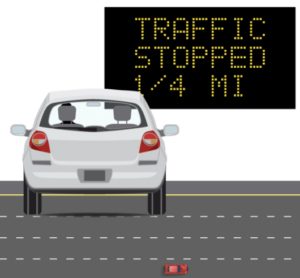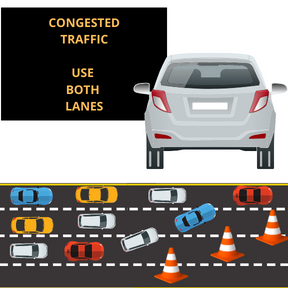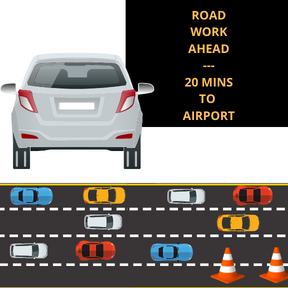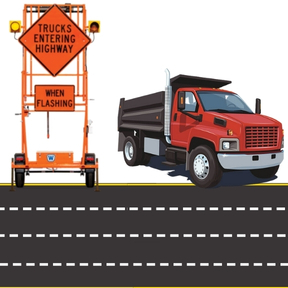What is a Smart Work Zone System?
Smart Work Zone Systems help prevent accidents, save lives and improve conditions in highway construction zones. They bring technology to the work zone to give motorists real-time information that allows them to make better driving decisions and avoid accidents.
Smart Work Zone Systems track real-time traffic conditions using intelligent technology such as radar detectors, Bluetooth sensors, cameras, and computer vision, and use cloud technology to provide warnings to motorists when they need it most.
The Dangers of Work Zones
The dangers associated with Freeway work zones are serious.
- National Highways 2019 Data: 762 deaths and 39,00 injuries in work zones, resulting from 115,000 crashes (1)
- Freeway work zones have higher than normal crash rates
- Occupational Deaths: According to the CDC, highway transportation incidents are the leading cause of occupational fatality in the U.S. (2)
- Sudden slow-downs in work zones often do not leave drivers sufficient time to stop and avoid collision with other vehicles, or with highway workers.
Smart Work Zone Systems Save Lives
Of course, everyone wants to avoid a horrible accident in their work area. By the time you’ve had a fatality in the work zone, the loss of life, the potential cost of lawsuits, the bad media, the damage has already been done.
But the good news is – You can protect your construction area using a Smart Work Zone System.
Smart Work Zone Systems help save lives:
- Independent research has shown smart work zone systems to reduce injury crash frequency which may lead to improved survivability. (3)
- Smart Work Zone Systems have also been shown in other studies to reduce speeds and calm traffic. (4)
- According to a study by the Texas Transportation Institute, Queue Systems were proven to reduce crashes by more than 50% and significantly reduced the overall severity of accidents (7).
The Different Types of Smart Work Zone Systems
Queue Warning Systems
Queue warning systems provide slow and stopped traffic warnings to motorists before they reach potentially hazardous traffic conditions, giving them time to slow down safely and avoid potential collisions.
They are one of the most important technologies for reducing accidents in the work zone. In fact, according to a study by the Texas Transportation Institute, Queue Systems were proven to reduce crashes by more than 50% and significantly reduced the overall severity of accidents (7).
These systems are especially useful in areas with low sight distance caused by horizontal or vertical curves.
Trucks Entering Roadway Warning Systems
When slow-moving construction vehicles exit the work zone into fast-moving highway traffic, it can create a hazardous situation and lead to traffic accidents. The Solution? The Trucks Entering Roadway Warning System. This real-time warning system immediately alerts oncoming motorists of construction vehicles entering the roadway, enabling them slow down, and change course to avoid accidents.
In this situation, mere seconds can be the difference between life and death. Because of this, QLynx Technologies incorporates lightning fast, millisecond communication technology in our Truck Warning Systems.
 Dynamic Lane Merge Systems
Dynamic Lane Merge Systems
Dynamic Lane Merge Systems (DLMS) are designed to improve safety and efficiency on roadways with a lane merge.
When traffic is congested, a DLMS system will advise motorists to merge late, thus reducing backups and increasing road capacity. When traffic is at free-flow, the system will advise motorists to merge earlier, thus smoothing merge patterns.
DLMS systems also often provide warning of slow and stopped traffic ahead, helping cars to slow down sufficiently for safety, as they approach the lane taper area.
 Travel Time Systems
Travel Time Systems
Travel time systems inform motorists of real-time travel times and delays through the work zone. These help reduce driver frustration and allow drivers to take alternate routes when work zone delays are heavy.
Travel time systems often incorporate queue warning as well, since both types of information can be collected using the same radar sensors.
Travel times can be monitoring using Bluetooth sensors or radar sensors.
Camera Monitoring Systems
Portable Camera Trailer systems allow you to remotely monitor real-time traffic conditions and broadcast them via the website to motorists or link to TMC employees. Easily monitor traffic and construction, and identify incidents.
Work Zone Pins
Work zone markers digitally identify the work zone area, for display on Waze, and integration with the WZDX (work zone data exchange), and other digital mapping services.
Additional Smart Work Zone Benefits
FHWA 2012 Data: 482,000,000 vehicle hours lost in driver delay times in work zones (1)
- Smart Work Zone Systems can provide real-time warnings of delays and suggest alternate routes to travelers, saving time and reducing frustration.
About $6.5 billion dollars, the value of 482 million hours, not including lost wages and lawsuits from deaths or injuries.
- Studies have concluded that Smart Work Zone Systems save more money than they cost. A recent study by Bushman et al showed a benefit to cost ratio between 1.2 to 11.9 (5)
- A 2005 study showed the cost/benefit ratio for travel time systems to be much greater than 1, even without considering safety, fuel, or emissions impacts. (6).
References
(1) 2019 National Highway Traffic Safety Administration (NHTSA) Fatality Analysis Reporting System and Crash Report Sampling System, US Department of Transportation. https://www.workzonesafety.org/crash-information/work-zone-traffic-crash-trends-and-statistics/
(2) Occupational Highway Transportation Deaths Among Workers Aged ≥55 Years — United States, 2003–2010, CDC Website, August 23, 2013. http://www.cdc.gov/mmwr/preview/mmwrhtml/mm6233a1.htm?s_cid=mm6233a1_e
(3) Lachhwani and Horowitz, Criteria for Portable ATIS, Center for Urban Transportation Studies, University of Wisconsin, October 2005, p23
(4) Lachhwani and Horowitz, Criteria for Portable ATIS, Center for Urban Transportation Studies, University of Wisconsin, October 2005, p63
(5) Bushman et al, Probabilistic performance model for evaluation of a smart work zone deployment, 2007, http://ecommons.usask.ca/handle/10388/etd-03192007-142727
(6) Lachhwani and Horowitz, Criteria for Portable ATIS, Center for Urban Transportation Studies, University of Wisconsin, October 2005, p61
(7) Texas Transportation Institute Queue System Study showing 53% reduction in crashes with use of a queue warning system, and reduction in severity of the crashes that did occur: https://ascelibrary.org/doi/10.1061/JTEPBS.0000084


